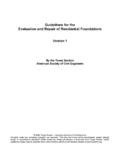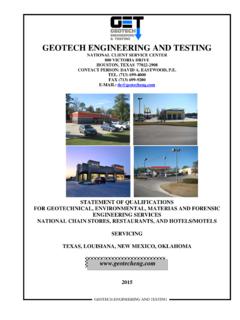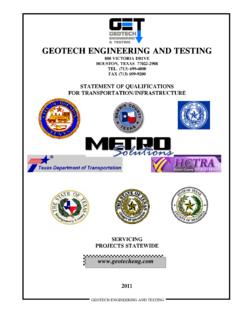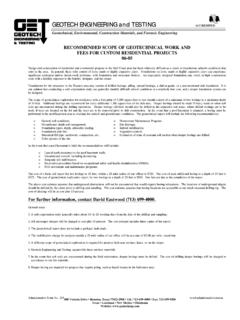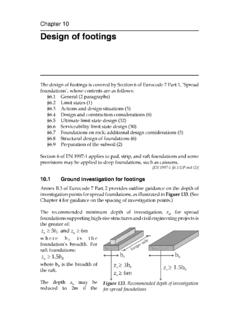Transcription of Foundations and Risks - About Geotech …
1 Foundations and Risks Many lightly loaded Foundations are designed and constructed on the basis of economics, Risks , soil type, foundation shape and structural loading. Many times, due to economic considerations, higher Risks are accepted in foundation design. Most of the time, the foundation types are selected by the owner/builder, etc. It should be noted that some levels of risk are associated with all types of Foundations and there is no such thing as a zero risk foundation. All of these Foundations must be stiffened in the areas where expansive soils are present and trees have been removed prior to construction. It should be noted that these Foundations are not designed to resist soil and foundation movements as a result of sewer/pluming leaks, excessive irrigation, poor drainage and water ponding near the foundation system. The followings are the foundation types typically used in the area with increasing levels of risk and decreasing levels of cost: Foundation Type Remarks Structural Slab With Piers This type of foundation (which also includes a pier and beam foundation with a crawl space) is considered to be a low risk foundation if it is built and maintained with positive drainage and vegetation control.
2 A minimum crawl space of six-inches or larger is required. Using this foundation, the floor slabs are not in contact with the subgrade soils. This type of foundation is particularly suited for the area where expansive soils are present and where trees have been removed prior to construction. The drilled footings must be placed below the potential active zone to minimize potential drilled footing upheaval due to expansive clays. In the areas where non-expansive soils are present, spread footings can be used instead of drilled footings. Slab-On-Fill Foundation Supported on Piers This foundation system is also suited for the area where expansive soils are present. This system has some Risks with respect to foundation distress and movements, where expansive soils are present. However, if positive drainage and vegetation control are provided, this type of foundation should perform satisfactorily.
3 The fill thickness is evaluated such that once it is combined with environmental conditions (positive drainage, vegetation control) the potential vertical rise will be reduced. The structural loads can also be supported on spread footings if expansive soils are not present. Floating (Stiffened) Slab Supported on Piers. The Slab can either be Conventionally-Reinforced or Post-Tensioned. The risk on this type of foundation system can be reduced sizably if it is built and maintained with positive drainage and vegetation control. Due to presence of piers, the slab cannot move down. However, if expansive soils are present, the slab may move up, behaving like a floating slab. In this case, the steel from the drilled piers should not be dowelled into the grade beams. The structural loads can also be supported on spread footings if expansive soils are not present.
4 Floating Super-Structural Slab Foundation (Conventionally-Reinforced or Post-Tensioned Slab) The risk on this type of foundation system can be reduced significantly if it is built and maintained with positive drainage and vegetation control. No piers are used in this type of foundation. Many of the lightly-loaded structures in the state of Texas are built on this type of foundation and are performing satisfactorily. In the areas where trees have been removed prior to construction and where expansive clays exists, these Foundations must be significantly stiffened to minimize the potential differential movements as a result of subsoil heave due to tree removal. The beauty of this foundation system is that as long as the grade beams penetrate a minimum of six-inches into the competent natural soils or properly compacted structural fill, no compaction of subgrade soils are required.
5 The subgrade soils should; however, be firm enough to support the floor slab loads during construction. The structural engineer should design the floor slabs such that they can span in between the grade beams. The subsoils within which the grade beams are placed must have a minimum shear strength of 1000 psf and a minimum degree of compaction of 95 percent standard proctor density (ASTM D 698-91) at a moisture content within 2% optimum moisture content. Floating Slab Foundation (Conventionally-Reinforced or Post-Tensioned Slab) The risk on this type of foundation can be reduced significantly if it is built and maintained with positive drainage and vegetation control. No piers are used in this type of foundation. Many of the lightly-loaded structures in the state of Texas are built on this type of foundation and are performing satisfactorily.
6 In the area where trees have been removed prior to construction and where expansive clays exists, these Foundations must be significantly stiffened to minimize the potential differential movements as a result of subsoil heave due to tree removal. However, foundation tilt can still occur even if the foundation system is designed rigid. The above recommendations, with respect to the best foundation types and Risks , are very general. The best type of foundation may vary as a function of structural loading and soil types. For example, in some cases, a floating slab foundation may perform better than a drilled footing type foundation.
